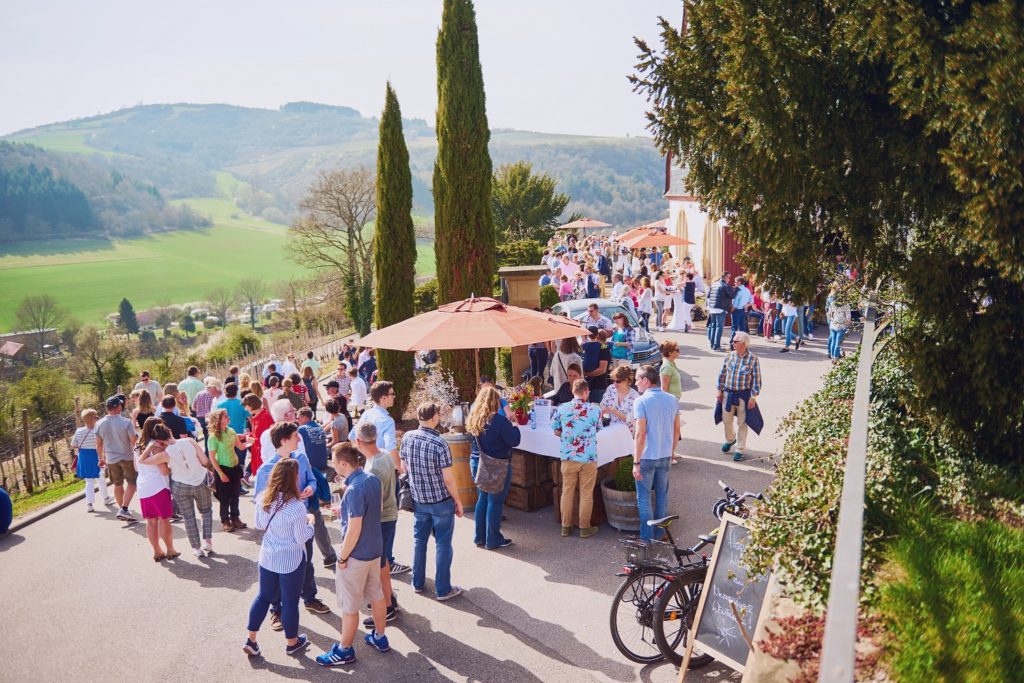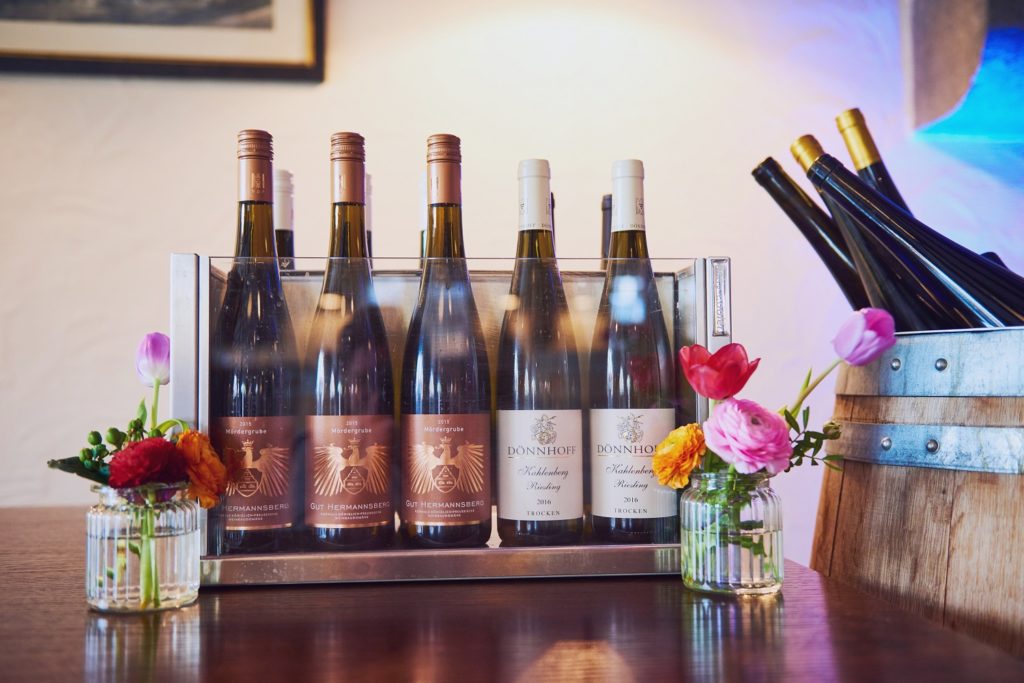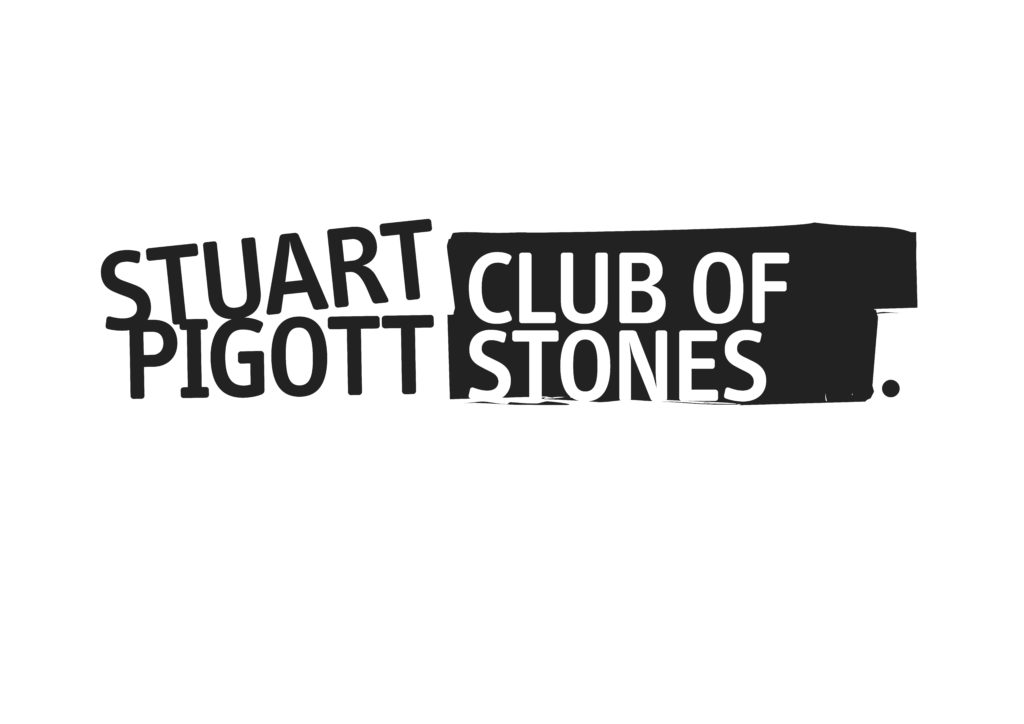 Die Wettervorhersage für Sonntag, den 7. April ist 17° C mit Sonne und ich habe ein Vorschlag für den Tagesprogramm: Niederhäuser Weinfrühling an der Nahe / The weather forecast for Sunday, 7th April is 17° C with sunshine. I suggest you visit the Niederhäuser Weinfrühling in the Nahe. For the English language story please scroll down.
Die Wettervorhersage für Sonntag, den 7. April ist 17° C mit Sonne und ich habe ein Vorschlag für den Tagesprogramm: Niederhäuser Weinfrühling an der Nahe / The weather forecast for Sunday, 7th April is 17° C with sunshine. I suggest you visit the Niederhäuser Weinfrühling in the Nahe. For the English language story please scroll down.
Seit ich Anfang März 2019 angefangen habe für Gut Hermannsberg (GHB) als Riesling Ambassador zu arbeiten, haben mir zahlreiche Menschen zwei bohrende Fragen gestellt. Erstens: Warum haben sie plötzlich den freischaffenden Weinjournalismus gegen die Arbeit für ein Weingut gewechselt? Zweitens: Warum ausgerechnet die Nahe? Die erste Frage verdient eine ausführliche Antwort und ich bitte um etwas Geduld. Die kurze Antwort darauf ist, dass ich wenig Zukunft in der Art von Journalismus, die ich die letzten zwanzig Jahre gepflegt habe, gesehen habe. Die zweite Frage können Sie selber beantworten, indem Sie am kommenden Sonntag, den 7. April den Niederhäuser Weinfrühling besuchen und diesen Teil der Nahe persönlich kennenlernen.
Meine persönliche Antwort auf die zweite Frage ist Liebe. Als ich 1984-86 anfing die Nahe zu besuchen, habe ich mich hoffnungslos in dieses Gebiet verliebt. Schnell habe ich einen Draht zu den damals bedeutenden Figuren an der Nahe, wie Hans and Dr. Peter Crusius von Weingut Crusius in Traisen, Armin Diel von Schlossgut Diel in Burg Layen, Helmut Dönnhoff von Weingut Dönnhoff in Oberhausen und Dr. Werner Hofäcker, den Direktor der Staatlichen Weinbaudomäne in Niederhausen (heute GHB) gefunden. Sie haben mich immer wieder zurück an die Nahe gezogen und schrittweise habe ich entdeckt, was diese Gegend so besonders macht. Die Nahe hat nur 4.205 Hektar Weinberge, ist aber ein ziemlich komplexes Gebiet mit einer erstaunlichen klimatischen und geologischen Vielfalt. Diese Komplexität wäre vielleicht frustrierend, wenn es nicht zu solch einer großen Vielzahl von sagenhaften trockenen wie auch natürlichsüßen Weißweinen, Schaumweinen und auch Rotweinen führen würde. Zweifelsohne wird die Mehrheit der genialen Naheweinen aus der Riesling-Traube (28,6% der Gesamtrebfläche) gewonnen, aber Weissburgunder (Pinot Blanc), Grauburgunder (Pinot Gris), Spätburgunder (Pinot Noir) und Chardonnay spielen auch eine bedeutende Rolle an der Nahe.
Für mich ist GHB ein besonderer Teil dieser Welt des Weins und nicht nur weil 100% des 30 Hektar großen Weinbergsbesitzes des Hauses als VDP Grosse Lage klassifiziert sind. Das Gutshaus und seine Nebengebäude stehen zwischen GHBs 12,5 Hektar der Lage Kupfergrube und seiner 5,5 Hektar großen Monopollage Hermannsberg fast direkt oberhalb des Flusses. Drum herum liegen die Felsen und steilen bewaldeten Hänge in diesem wildromantischen Abschnitt des Tals. Aber sie müssen mir nicht glauben, kommen Sie einfach am nächsten Sonntag oder ein anderen Mal und schauen Sie sich das ganze von unserer Terrasse aus an. Dann sind Sie das Juwel in unserer Krone!
Das Beste an meiner neuen Rolle bei GHB ist die frappierende Weise, wie jeder der trockenen Rieslinge seine besondere Herkunft geschmacklich widerspiegelt. Das hat viel mit der harten Arbeit und Zielstrebigkeit von Winemaker Karsten Peter und dem Weinbergsverwalter Philipp Wolf zu tun, aber auch mit dem Wirken des ganzen Teams, unter Direktor Achim Kirchner und Jasper Reidel von der Besitzerfamilie. Wie Warren Winiarski, der Gründer von Stag’s Leap Wine Cellars in Napa Valley/Kalifornien mir einmal gesagt hat: „Terroir ist taub bis jemand es entdeckt und einen Weg herausarbeitet über den es zum Ausdruck kommt.“ Jedes der führenden Weingüter der Nahe hat eine eigene Geschichte, wie ihnen das gelungen ist. Lernen sie das am kommenden Sonntag, den 7. April in Niederhausen und auf GHB kennen! (Fotos: Nathalie Schwartz)
#GHBistmeinDRC #7Terroirs #LieberNahealsFerne #Nahe #Riesling

Since I started work for the Gut Hermannsberg (GHB) estate in Niederhausen/Nahe as Riesling Ambassador at the begining of March 2019 many people asked me two questions: Why switch from wine journalism to working for a wine producer? Why the Nahe? The first of these will require a lengthy answer at some point in the near future, but the quick version is that I don’t see a long-term future for the kind of wine journalism I dedicated myself to for the last twenty years. The second question is much easier to answer and you don’t even need to read the following to do so, just come to the Niederhäuser Weinfrühling next Sunday, 7th April in Niederhausen/Nahe and experience it for yourself.
My own answer to that second question is love. During my first trips to the Nahe in 1984 – 1986 I fell head over heels in love with this dramatic region and rapidly connected with several of the leading producers there. My contact with Hans and Dr. Peter Crusius of the Crusius estate in Traisen, Armin Diel of Schlossgut Diel in Burg Layen, Helmut Dönnhoff of the Dönnhoff estate in Oberhausen and Dr. Werner Hofäcker of the Staatliche Weinbaudomäne in Niederhausen (GHB today) pulled me back again and again to find out ever more about what makes the Nahe so special. The fact is that although it only has 4,205 hectares of vineyards it is geologically and climatically diverse is crucial. That might be frustrating if it wasn’t for the fact that it leads to an astonishing diversity of wonderful dry white, sweet, sparkling and red wines. Yes, the Riesling grape (28.6% of the total vineyard area) gives the majority of the great wines of the Nahe, but Weissburgunder (Pinot Blanc), Grauburgunder (Pinot Gris), Spätburgunder (Pinot Noir) and Chardonnay all play important roles.
For me, GHB is a special part of this world of wine, and not only because 100% of its 30 hectares of vineyards are classified as VDP Grosse Lagen. GHB’s 12.5 hectares in the Kupfergrube site on two side of most of them lie directly around the complex of estate buildings, and the 5.5 hectare monopole Hermannsberg site lied on the other, the river Nahe forming the forth side. Beyond those vineyards lie the volcanic cliffs, and forested sleeps that make this section of the river valley breathtakingly beautiful. But don’t take my word for it. Come along to GHB on Sunday and experience for yourself the view from our terrace. Then you’ll be the jewel in our crown!
The best thing about my new role for GHB is the arresting way each of the wines dramatically reflects its place of origin. That has a great deal to do with the hard yet thoughtful work of winemaker Karsten Peter and vineyard manager Philipp Wolf, supported by the entire GHB team under director Achim Kirchner and including Jasper Reidel of the owning family. As the great Californian winemaker Warren Winiarski of Stag’s Leap Wine Cellars in Napa Valley said to me many years ago, „Terroir is mute until someone recognizes it and enables it to express itself.” Each of the leading producers of the Nahe has their own story of how they did that. Come and experience this for yourself on Sunday, 7th April in Niederhausen and at GHB! (Photos: Nathalie Schwartz)
#GHBismyDRC #7Terroirs #LoveNahe #Nahe #Riesling

